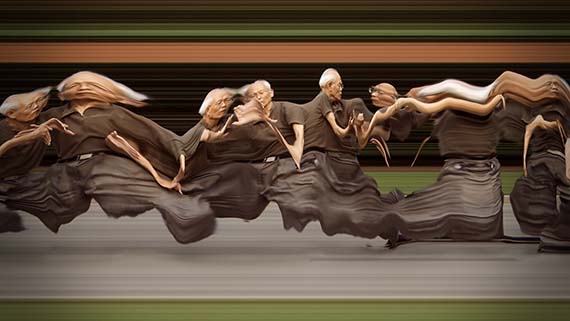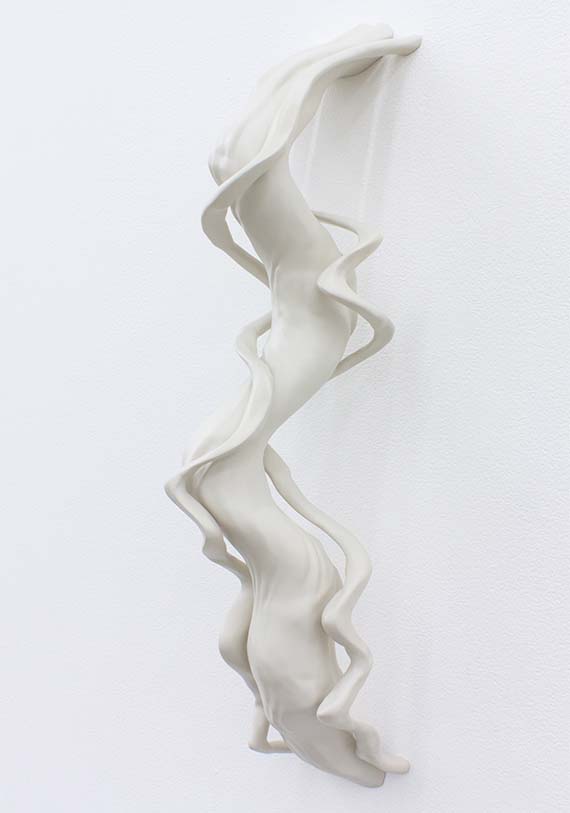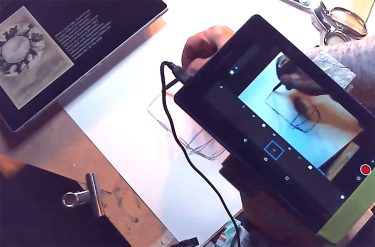
‘Daniel Crooks: Motion Studies’ currently showing at the Gallery of Modern Art (GOMA) until 25 October traces the Melbourne artist’s sublime ‘time slice’ projects, from his early works in digital video through to his more recent sculptural forms.
‘The poetic image is a sudden salience on the surface of the psyche.’ 1
Gaston Bachelard
There is a shimmering moment, just on awakening, when a dream skims over your consciousness. A drowsy dance on the borders of awareness, a liminal moment — a reverie, as philosopher Gaston Bachelard calls it — when the mind is open to all possibilities, unfettered by the logical demands of the waking world. It is in this pliable drift that you will find the eloquent and striking spatiotemporal works by Daniel Crooks, one of the leading contemporary artists working in moving image today.
Known for his signature ‘time slice’, which creates a lyrical dislocation of time and space through the displacement of thin slices of pixel material in the video sequence, Crooks celebrates moments of the seemingly mundane, embracing the repetitive cadences of commuters traversing urban spaces or engaging with elevators, trains and trams, to reveal an eddying, dreamlike choreography at odds with the restlessness of the fast-paced modern life from which they are drawn. Using customised computer software and a precision camera motion control — devices he built to allow him to control the movement and speed of the camera during filming — Crooks harnesses the power of digital production and editing to give shape, structure and meaning to the material recorded. Creating expressive beauty in motion, the warped fluidity of his work alters the viewer’s perception of time with clever contextualisation. While Crooks intercedes to offer a fresh perspective on the explicit treatment of time as a physical, malleable material, he retains the familiarity of the core imagery, tethering it to a world that people know and experience every day.
‘Daniel Crooks: Motion Studies’ is the artist’s first solo exhibition at GOMA. It traces his time slice projects from his early works in digital video through to his more recent sculptural forms — a new area of practice made possible through an Ars Electronica Futurelab Residency in Linz and a recent Creative Australia New Work grant from the Australia Council, both in 2014.2
Born in 1973 in Hastings, New Zealand, Crooks completed a Postgraduate Diploma at the Victorian College of the Arts School of Film and Television in 1994 and has lived and worked in Melbourne since then. Originally planned as a whistle-stop on the way to New York, Melbourne ‘lured him in’ and has become his home base amid a growing schedule of national and international engagements, including such prestigious accolades as the Basil Sellers Art Prize, Inaugural Acquisitive Award, from Melbourne’s Ian Potter Museum in 2008, and the Ian Potter Moving Image Commission in 2014; group exhibitions at the Barbican Centre and Tate Modern in London and the Singapore Art Museum; and solo shows in Australia, New Zealand, Japan and the Netherlands.
The early germinations of Crooks’s time slice project can be traced back as far as his formative years at school, through those who encouraged his interests in photography and geometry. However, it was his time at the Victorian College of the Arts that saw these ideas coalesce during the creation of his graduation project in 1994: a painstaking stop-motion process that required repeated photographing of microscopic movements to create a sense of movement over time. As Crooks describes it:
You’re working at this glacially slow pace and looking at all the individual static moments that make up any kind of movement. So as soon as you go into the real world, you just start seeing that everywhere. You see those moments when a hand floats for a moment and then stops moving. When you look at people walking, you see the infinitesimal lift of the toe that clears the ground as they’re swinging through, and the tenth of a millimetre that it misses by, and it’s all just perfect.3
His epiphany came a few years later while working with timelapse pan photography: having received a New Media Arts Residency at RMIT in 1997, through the Australia Council New Media Arts Board, to build the early iterations of the precision camera motion control devices he uses today, Crooks began digitally slicing the still images he was capturing into thin strips before reassembling the image and spreading these across the frame. By experimenting with the width of the slice, the angle of the view and the temporal resolution of the camera Crooks was able to determine the ‘plane of cohesion’ — a point from the camera where objects joined seamlessly across the multiple slices to create an undistorted image, as he puts it ‘a kind of spatio-temporal depth of field’.4

The result was a sense of movement, a jitter, as Crooks describes it — an unfolding poly-ocular view of a moment with a depth of interpretation hitherto unseen. He quickly began to explore the technique with moving image, creating some of his most important early video works such as Elevator No.4 2003 and Train No.1 2005 incorporating these syncopated movements. It was also during this time, while filming the camera motion control device to check its calibration, that Crooks noticed the Lego block he had used as a measure was creating a fascinating helical image. Replacing the block with a piece of white crumpled paper he found in the studio, Crooks made another serendipitous discovery: by capturing timelapse images of paper spinning on top of the device he was able to create high-resolution swirling helical structures with a stunning depth of field. Highly sculptural, Crooks captured these malleable extrusions in his ‘Imaginary object’ series as both photographic and video form, varying the width of the displaced pixel slices to turn his humble crumpled paper into temporal objects with textural characteristics reminiscent of milk, silk and marble.

With each successive time slice work, Crooks has continued to push the boundaries of the process. His more recent works, such as Static No.12 (seek stillness in movement) 2010 and Static No.19 (shibuya rorschach) 2012, largely eschew the staccato rhythms of earlier works to embrace a fluidity in which the footage begins to stretch and melt to the edges of the screen. Most recently Crooks’s practice has also seen the actualisation of a goal he has held for a number of years: the ability to extend beyond the screen the temporal forms that have emerged through his practice, to be realised as three-dimensional objects. Constructed from sequences of two-dimensional slices through a combination of motion-capture technologies and depth-sensing cameras, Crooks likens the process to capturing movement ‘in the same way the surface of a lake experiences the body of a swimmer or a boats hull over time, I’m looking for a way to capture a sequence of cross-sections’.4 The resulting series ‘Truths unveiled by time’ reflect the warped extrusions of movement apparent in many of his time slice videos alongside the tactile and dimensional qualities of his ‘Imaginary object’ series.

Since the inception of Crooks’s manipulations of video through to his recent move into sculptural works, he has continued to challenge both the medium and outcome, creating extraordinary meditations on the relations between temporal and spatial displacement. This exhibition allows the viewer to trace the evolution of this practice which, like the works that it has created, moves with a graceful fluidity through time and space.
Endnotes
1 Gaston Bachelard, La Poetique de l’Espace (The Poetics of Space), Presses Universitaires de France, 1958, reprinted by Penguin Books, New York, 2014.
2 Crooks attributes the use of the phrase ‘time slice’ to Tim Macmillan, who created the first multi lens camera through which to capture extreme slow-motion 360-degree views of a single moment. Created in 1980, the technology is now more commonly known as ‘bullet time’ and is often used in Hollywood films such as The Matrix 1999.
2 Lawrence Weschler, A Conversation with Melbourne Video Artist Daniel Crooks, Anne & Gordon Samstag Museum of Art University of South Australia, Adelaide, 2013, p.7.
3 Weschler, p.12.
4 Discussions with the artist, June 2013.


